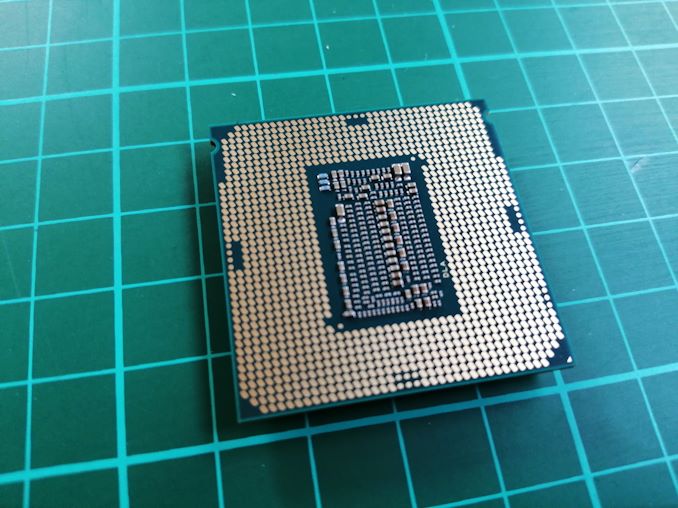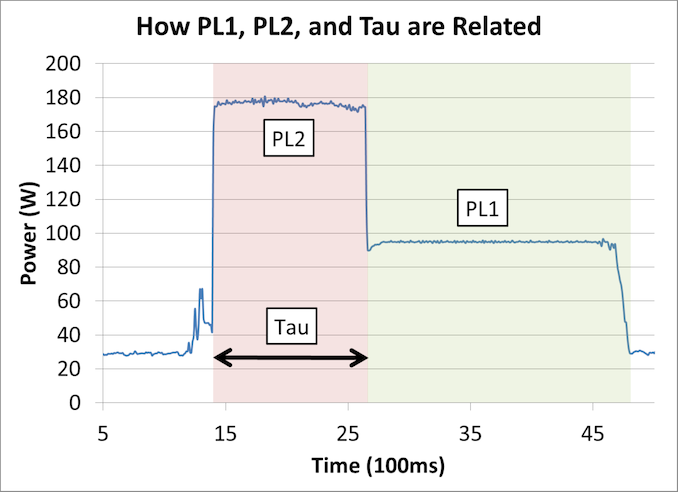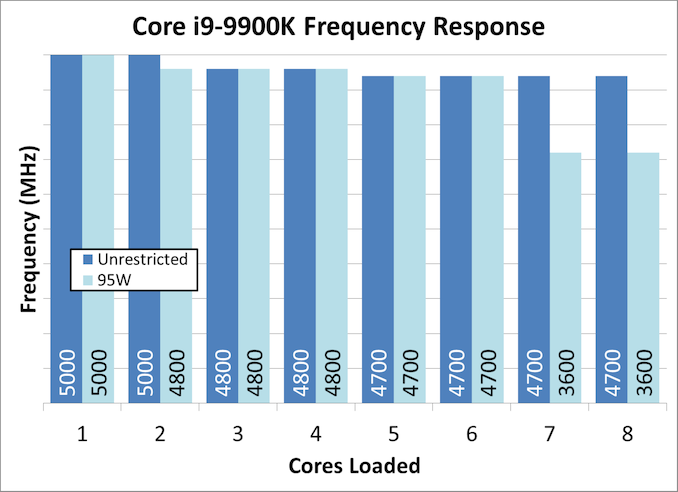The Intel Core i9-9900K at 95W: Fixing The Power for SFF
by Ian Cutress on November 29, 2018 8:00 AM EST
There is a lot of discussion about processor power recently. A lot of the issues stem around what exactly that TDP rating means on the box, and if it relates to anything in the real world. A summary of Intel’s official declaration boils down to TDP as the sustained processor power at long periods, however almost zero motherboards follow that guideline. As a result users will usually see much higher sustained power, although with much higher performance. Some small form factor systems rely on setting these limits, so we tested a Core i9-9900K with a 95W limit to see what would happen.
Intel and TDP
We recently published a sizeable analysis on what Intel officially means by TDP, and the associated values of PL1, PL2, and Tau. You can read it all here, although what it boils down to is this diagram:
When a processor is initially loaded, it should enter a state where PL2 describes the maximum power for a time of Tau seconds. When in this PL2 state, the CPU follows Intel’s per-core Turbo table rules, which reduces the frequency based on the number of cores loaded.
After Tau seconds, the CPU should drop down to a PL1 maximum sustained power value, which is usually identical to TDP. Depending on the CPU, this may reduce the frequency to the base frequency, or well below the all-core turbo frequency.
Technically PL2 is obtained over a moving average window, Tau, such that any low power moments on the processor will 'give budget back' to the turbo mode, however the graph above is the easiest way to see the high turbo mode on a fully loaded processor.
So while Intel defines a value for PL1, PL2, and Tau, almost zero consumer motherboard manufacturers actually follow it. There are many reasons why, mostly relating to overengineering the motherboards and wanting users to have the best performance at all times. The only times where these values follow any form of Intel guidance is in small form factor PCs.
For example, I tested an MSI Vortex G3 small form factor desktop at an event last year. It was using a processor normally rated for 65W TDP, and in a normal desktop that processor would push over 100W because the motherboard manufacturer in that system did not put any limits on the power, allowing the power to fall within Intel’s per-core turbo values. However, in this Vortex system, because of the limited thermal capabilities, the BIOS was set to run at 65W the whole time. This made sense for this form factor, but it meant that anyone looking for benchmarks of the processor would be misled – the power profile set in the BIOS was in no-way related to how that CPU would run in a standard desktop.
A Core i9-9900K with a 95W Limit
To put this into perspective, for this review we are using a Core i9-9900K which has a sustained TDP rating of 95W. When we compare the per-core frequencies of a 95W limited scenario and a normal ‘unrestricted scenario’, we get the following:
When a single core is loaded, the CPU is in 5.0 GHz mode as we are well under the power limit. There’s a slight decrease of 200 MHz in the 95W at two cores, but this disappears when 3-6 cores are loaded, with both setups being equal. The major difference happens however when we are at 7-8 cores loaded: because of the power consumption, the Core i9-9900K in 95W mode drops down to 3.6 GHz, which happens to be its base frequency.
This arguably means that we should see a correlation in most benchmarks between the two parts, but not if maximum load is ever required.
This Review
For this review, we’re putting the Core i9-9900K at a 95W power limit (as measured by the internal registers of the system) and running through our CPU test suite to see if how large the performance deficit is between the Core i9-9900K in a thermally unlimited scenario compared to a small form factor system deployment.
Pages In This Review
- Analysis and Competition
- Test Bed and Setup
- 2018 and 2019 Benchmark Suite: Spectre and Meltdown Hardened
- CPU Performance: System Tests
- CPU Performance: Rendering Tests
- CPU Performance: Office Tests
- CPU Performance: Encoding Tests
- CPU Performance: Legacy Tests
- Conclusions and Final Words












101 Comments
View All Comments
DennisBaker - Tuesday, December 4, 2018 - link
I wanted to build a new PC on Black Friday, and I bought an i9-9900k. I never overclock and typically buy a locked/non-k CPU but couldn't wait until next year. I also always use a SFF case (Cooler Master Elite 130).This is a great article, but I'm not sure how to actually set the bios for a 95w max cpu setting.
I have the Asrock z390 phantom gaming-itx/ac motherboard:
http://asrock.pc.cdn.bitgravity.com/Manual/Z390%20...
I've been googling without success and figured I would just ask here if there is a general guide for this.
Targon - Thursday, November 29, 2018 - link
The real question is real world performance. If the goal is a SFF machine where you don't have closed loop coolers, and you have a small ITX motherboard and a small case, what will happen to temperatures in those cases. That is where you get heat related issues with performance.We know that the 2700X hits 4.3GHz, 4.4GHz in some situations, but put it in an ITX case, benchmark it. Will the i9-9900k end up being all that much faster when you are pushing your machine, not just in games, but when you are using your system as an 8 core system where you have web browsers, mail, MS Word, plus other things open at the same time? With all of this running, then go to it with your benchmarks. Compare how well the 2700 and 2700X perform without overclocking and just use the defaults to allow boost/turbo to operate. Is the 9900k all that much faster when playing games with that other stuff still running in the background? Push it for an hour of nonstop use to make sure that you are seeing how well the chip will work in the real world(when used by enthusiasts).
At that point, will we see the average CPU speed be 4GHz, or will it be down in the 3.6-3.7GHz range? Would the Ryzen chips at that point be faster in a SFF case than the i9-9900k?
HStewart - Thursday, November 29, 2018 - link
Another factor here is that it not CPU that uses the power, one must also include the power consumption of the GPU which is a lot of time significantly more power than the CPU.But in normal peoples usage in real world - the cores are not running as much. It requires that the software to be designed multithreaded or multiple applications running at the same time - the major problem is video is often have to single threaded. In the real world every one is not a hard core gamer.
One also remember that previous we had more desktop and all had external GPU's - but now with most of market - especially business market is mobile, the desired for high performance, high power system is not as important. So power savings modes is important to customers.
This is not just important for PC's - just this morning, I got message on my Samsung Note 8 that my settings was causing my phone to use battery
It really must be take in perspective of users needs - for hard core gamers - more cores, external GPUs are important. But for most users using Office and such, Internal GPU and dual core is fine.
BurntMyBacon - Thursday, November 29, 2018 - link
@HStewart: "It really must be take in perspective of users needs - for hard core gamers - more cores, external GPUs are important. But for most users using Office and such, Internal GPU and dual core is fine."Which group of users that you defined do you suppose is the target audience for the i9-9900K tested in this article?
HStewart - Thursday, November 29, 2018 - link
"Which group of users that you defined do you suppose is the target audience for the i9-9900K tested in this article?"Yes I realize that - but appears that people in this category tend to believe they are the only category. Also not all Hardcore Gamers are overclockers. I would say I done a lot of game in my life and even at 57 I still do. But all that time unless done by the manufacture, I have really not done it. I believe both my XPS 13 2in1 and XPS 15 2in1 have some built in over clocking but it is control by system.
All I am saying is everyone does not over clock and hard core games.
Targon - Thursday, November 29, 2018 - link
You don't need to manually overclock to enjoy the benefits of how long the processor can run at turbo speeds, vs. base speeds. If a chip can turbo to 5GHz all the time due to good cooling, then that will mean that even without manually overclocking, that CPU will have a much higher performance than lower tier chips. On the other hand, if the cooling isn't very good, then it will stay at base speeds most of the time.Small Form Factor....the beauty of having a small machine. If it also means that the performance will be limited due to cooling, then why bother paying for a faster processor when a slower processor will be almost as fast at half the price?
What many want to see are real world situations. People do not buy a 9900k if they don't want high performance, even if they do not manually overclock. So, 8 core/16 thread, because why pay for that if 4 core/8 thread, or 6 core/12 thread will perform just as well if not better? Same case size, will the 9900k be faster than a Ryzen 7 2700X in the same SFF case if the 9900k can't be cooled well enough to keep the chip running faster than base speeds? What would you do if the 2700X, which doesn't bench as well, were actually better at holding turbo/boost speeds in a SFF environment? Do you expect a SFF machine to have a discrete video card(which Intel chips don't necessarily need, even if the people who buy a 9900k will almost always put one in)?
Laptops are not the target of this article(no 9900k has ever been put into a laptop), so laptop boost/turbo results will be a bit more difficult because the design of the laptop itself won't allow a fair apples to apples comparison, unless you could swap the motherboards/processors while keeping the same motherboard/cooling.
HStewart - Thursday, November 29, 2018 - link
I understand laptops are not target of this article - but some crazy laptop makes like to put desktop components into perverted laptop.Like it not this industry is moving away from desktop components and not just laptops - all and ones are perfect example. The closet thing that Apple has to desktop is iMacMini. In ways even servers are changing - blades are good example.
As far as SFF concern mobile chips are idea for it - and a solution like EMiB is perfect for increase graphics performance - exceor the GPU in my Dell XPS 15 2in1 is just not inpar with NV|idia - Intel made a bad choice teaming up with AMD on it - don't get me wrong against iGPU - it is awesome and better than older generation NVidias like 860m
Manch - Friday, November 30, 2018 - link
And there it is. I was wondering how you were going to steer towards bashing AMD. LOLTheinsanegamerN - Thursday, November 29, 2018 - link
When you are not using the iGPU, it is powergated off. It isnt using any power, or if it is, it is minute to the point where it doesnt matter.People have been saying, for years, that the iGPU was a detriment to OCing and power usage. The existence of HDET has proven that idea wrong many, many, many times over.
Icehawk - Thursday, November 29, 2018 - link
How does HDET prove that an iGPU isn't a detriment to OCing or power usage? One might be able to argue that the dead silicon provides some sinking & surface area